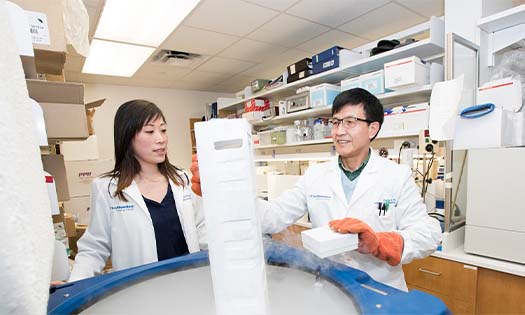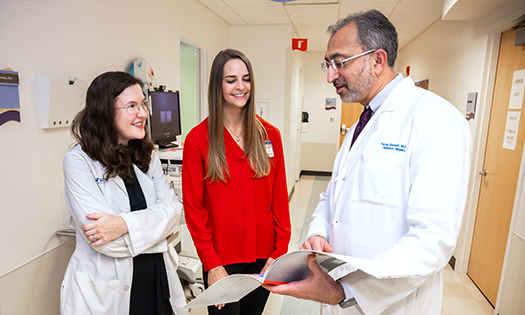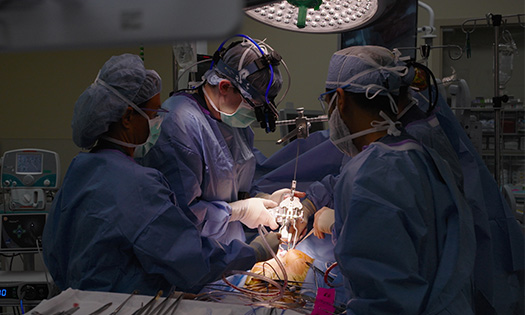For pediatric patients with spasticity, whether from cerebral palsy or other neurological injury, the best treatment option may seem to be in a gray zone rather than a clear-cut decision. When patients with spasticity run out of pharmaceutical options, it can be challenging to discern which neurosurgical treatment option is right for them. Determining the right course of action requires expertise from multiple perspectives on this complex condition.
The monthly pediatric spasticity multidisciplinary conference at Children’s Health℠, brings together the expertise of the brightest minds in neurosurgery, neurology, orthopedics, and physical medicine and rehabilitation. Working as a cohesive unit offers the best approach to complex muscle tone issues, according to Brett Whittemore, M.D., Pediatric Neurosurgeon at Children’s Health and Assistant Professor at UT Southwestern.
“Because there are many variables with managing spasticity, treatment must be tailored to each individual, rather than strictly following a protocol. Our team’s depth of experience in all aspects of spasticity enables us to examine each case from a broad view. This helps us work with families on their individual goals while keeping their care close to home where patients and caregivers are more comfortable,” Dr. Whittemore says.
Below are two recent case studies that demonstrate how the team works together to provide the best spasticity treatment options for each patient and deliver the best outcomes.
Case study #1: Intrathecal trial and baclofen pump
A teenage male was born with a brain malformation that delayed his speech and motor skills. He had hypertonia in his legs and arms from two neurological conditions that cause muscle stiffness – spasticity and dystonia – which made life difficult for him and his caregivers. He was taking oral baclofen, but the benefits were offset by side effects. He had persistent stiffness that severely affected his quality of life and daily care, including his hygiene.
To find the best treatment, Dr. Whittemore worked with Rajashree Srinivasan, M.D., Associate Medical Director at the Integrated Therapy unit at Children’s Health, and Associate Professor at UT Southwestern. Although a rare medication for dystonia addressed the stiffness in the arms, intrathecal baclofen could have a good effect on both conditions while leaving options open for further surgical procedures, such as selective dorsal rhizotomy (SDR), if needed.
“We had a long discussion about him in our monthly meeting to get feedback from everyone on the team, including the neurologist that prescribed the medication for dystonia. Together, we decided to continue the dystonia medication and trial intrathecal baclofen to try to eliminate side effects like nausea, headaches, confusion and constipation, while increasing the effectiveness over oral medication,” Dr. Whittemore says.
When the initial intrathecal baclofen test yielded significantly looser muscles, the team implanted the pump. Three weeks later, the patient, his caregivers and his rehab team were thrilled with the results – his legs were much looser, making it easier to care for his hygiene needs.
Now, Dr. Srinivasan and her team can adjust the baclofen dosage to the ideal amount and continue fine-tuning the treatment plan to address spasticity in his arms.
“The baclofen pump works well for the legs but doesn’t treat the arms, so we may use Botox or another modality in the arms. Collaborating allows us to find the best options for each patient using a variety of modalities,” Dr. Srinivasan says.
Case study #2: Selective dorsal rhizotomy after baclofen pump
Every patient with spasticity is different, and some treatments are only temporary fixes. That was the case for a non-ambulatory teenage male with cerebral palsy who needed a new treatment option. He had a series of intrathecal baclofen pumps since age 7 and experienced repeated pump infections. The pump became infected after a routine pump replacement, an uncommon but unfortunately unavoidable complication in some patients.
Given the patient’s limited movement potential, the team decided on a selective dorsal rhizotomy rather than using Botox or other oral medications, which did not work well enough for him.
“We typically do palliative rhizotomies for patients who cannot walk because it makes it easier for others to help with their care,” Dr. Whittemore says. “We use a less invasive method with only one level of exposure, which results in faster recovery times and less pain. We also use this technique for patients who can walk but are held back by the spasticity in their legs.”
Dr. Whittemore was assisted by Robert Rinaldi, M.D., Division Chief of Pediatric Rehabilitation Medicine and Professor at UT Southwestern. Dr. Rinaldi’s background in electrophysiology was instrumental in identifying which rootlets to cut in the operating room. The surgical team was able to loosen the afflicted muscles in the lower extremities as expected, with a pleasant side effect of partial loosening in the arms as well.
After the surgery, the patient was much more comfortable, his daily care was easier, and his family was relieved to have a permanent treatment.
Collaborating to deliver the best outcomes and fuel future research.
The multidisciplinary team at Children’s Health has the expertise to offer all treatments for spasticity, and it’s easier for children to access the care they need because all specialties are co-located within the same facility.
Close collaboration across disciplines also enables the team to pursue research that will have the biggest impact on spasticity patient care. In 2023 – 2024, Dr. Whittemore and his colleagues plan to work on several cooperative research projects. One research goal is to better understand the ancillary benefits of SDR by exploring the downstream effects of the treatment on bowel function and upper extremity tone.
Learn more about innovative neurosurgery care at Children’s Health and refer a patient


